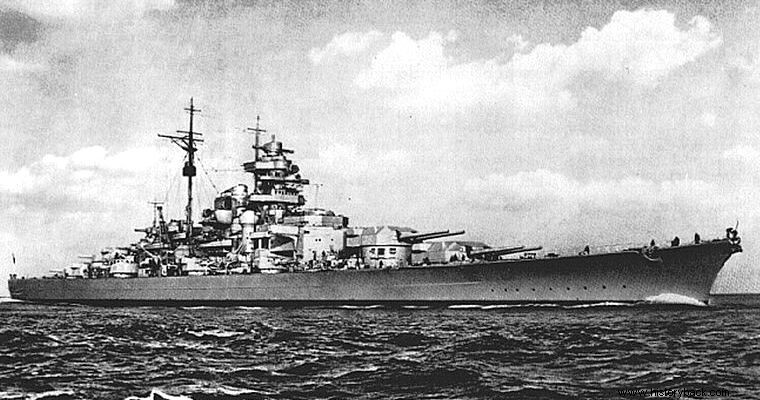
The Treaty of Versailles, after the end of World War I, imposed on defeated Germany the surrender of the extremely powerful fleet it had managed to assemble at that time. The German navy persisted with very few warships. Nevertheless, in the 1930s plans began to be made for new powerful naval units, among them battleships.
Design of Bismarck and her sister ship Tirpitz began in 1932, before Hitler came to power. In 1934 the development of the 15in (380mm) guns began. The vessel's keel was laid on 1 July 1936 and the vessel was launched in February 1939. The necessary trials followed and on 24 August 1940 the vessel was declared operational. During the tests, however, it presented a problem in the ability to turn quickly.
The Bismarck was based on an older design, that of the Baden-class battleships of 1916-17. As main armament it carried 8 SK C/34 guns of 380mm caliber that could fire a projectile weighing 800 kg at a distance of up to 36,500 m at an angle of 30 degrees.
The guns were mounted in four twin turrets, two each in the forward and aft sections. Secondary armament consisted of 12 150mm (5.9in) guns mounted in six twin turrets, three each on either side of the superstructure.
She also had 16 twin 10cm (105mm) heavy anti-aircraft guns, 16 twin 37mm anti-aircraft guns and 12 20mm anti-aircraft guns. It had a twin catapult and four Arado Ar 196 reconnaissance seaplanes.
It had a normal displacement of 41,700 t. and full 50,900 t. It was 251 m long, 36 m wide and 10.2 m draft. The vessel had three Blohm &Voss steam turbines powered by 12 Wagner boilers and produced 138,000 hp. The boat had three propellers and could develop a maximum speed of 29 knots.
Unlike the newer Allied battleships, her armor was based on World War I standards. The battleship belt was 8.7 – 12.6 in thick. (220-320mm). The armor of the decks had a minimum thickness of 50 and a maximum of 130mm. The main gun turrets had 7-14.1in. (180-360mm) armor while the armored combat control center was protected by 8.7-13.8in armor. (220-350mm). The vessel had a crew of 2,092 men.
On 19 May 1941 Bismarck sailed from Bergen, Norway escorted by the heavy cruiser Prinz Eugen. The two vessels participated in Operation Rheinübung (Exercise Rhine) the aim of which was to hit convoys supplying Britain. The flotilla was headed by Vice-Admiral Günther Lütjens.
The orders he had received said that his target was enemy merchant ships. They would engage in hostile hostilities only if necessary. The initial phase of the operation started dreamily for the Germans. The British, watching the movements of their opponents, had sent to meet them their theoretically best warship, HMS Hood, which carried the same Bismark main armament, and the newly built battleship HMS Prince of Wales, which carried 10 14in guns .
In the collision that followed, however, the Bismarck sank the Hood with its fifth destroyer. He then caused serious damage to the second British battleship as well, forcing it to abandon the fight. After this development, it was a matter of honor for the British navy to destroy this dangerous adversary.
However, the Bismarck had not come out unscathed from the naval battle. She had been hit by three 14in shells from the Prince of Wales and so it was decided to return her to Brest Naval Station in France. But the German battleship was being pursued by the British ships. On 24 May she was hit by an aircraft torpedo from the aircraft carrier HMS Victorius, but the damage was not serious.
The German boats managed to elude their pursuers. But then the German vice admiral made the fatal mistake of breaking radio silence. So the boats were spotted. On 26 May Bismarck received another fatal torpedo attack, this time by Swordfish aircraft from the aircraft carrier HMS Ark Royal. A torpedo hit the boat's rudder, essentially condemning it to death.
At midnight on the 26th Lütjens sent his last signal:“The ship is out of control. We will fight to the last shell. Hail Hitler". The next morning, 27 May 1941, however, Bismarck found the British battleships HMS Rodney and HMS King George V with their escort vessels opposite her. The Rodney carried nine 16in guns. and the King George V 10 of 14in. Soon the British fire began to hit the German vessel.
Even then, however, the Bismarck refused to die. So the heavy cruiser HMS Dorsetshire approached it and hit it three times with torpedoes. Finally the boat sank. Only 115 men of her crew were rescued as the British feared attack by German submarines. This was the end of the German giant of the seas.
